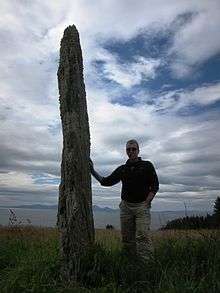Ballochroy

Ballochroy is a megalithic site in Kintyre on the Argyll peninsula in Scotland.[1] It consists of three vertical stones, side by side, aligned with various land features 7–19 miles (11–31 km) away.
Alexander Thom, known for his work on Stonehenge, maintained that the great length between the stones and the features of distant landscape lent precision to pinpointing the midsummer and winter solstices for ancient observers.
These three stones are considered the most spectacular set of megalithic monuments that cluster around south Argyll. The three mica schist stones were measured at 11 ft 6 in, 9 ft 10 in and 6 ft 7 in (3.5, 3.0 and 2.0 m) in height. It is possible that this last, smallest, stone may have been broken off at the top. The line of stones is orientated north-east to south-west.
The flat face of the central stone (at right angles to the alignment) indicates the mountain of Cora Bheinn, on the island of Jura, which is 19 miles (30 km) away. The shortest stone also faces across the alignment, and points to Beinn a' Chaolais, the southernmost of the three Paps of Jura. The sun setting here would have given warning of the approach of the solstice.

As with many megalithic sites, the current theories concerning the exact use of the stones at Ballochroy are somewhat controversial.
See also
References
- ↑ Cope, Julian (1998). The Modern Antiquarian: A Pre-millennial Odyssey Through Megalithic Britain : Including a Gazetteer to Over 300 Prehistoric Sites. Thorsons Pub. p. 349. ISBN 978-0-7225-3599-8.
External links
- Map sources for Ballochroy
Coordinates: 55°42′35″N 5°37′11″W / 55.70979°N 5.61978°W